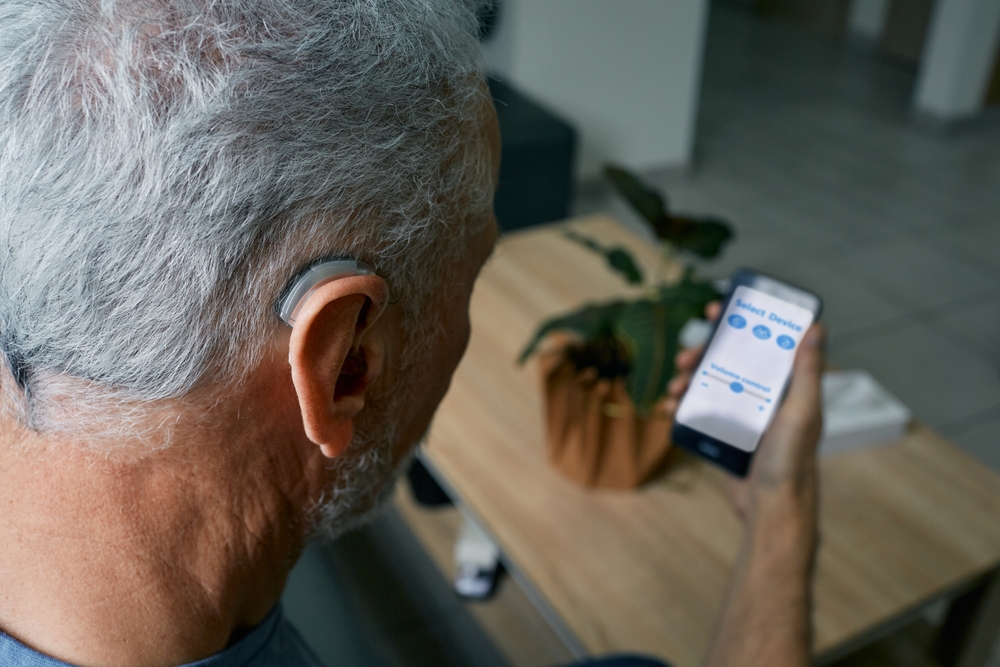What is a cyborg? If your mind gets swept up in science fiction movies, you probably think of cyborgs as kind of half-human, half machine characters (these characters are usually cleverly used to comment on the human condition). Hollywood cyborgs can seem wildly outlandish.
But the reality is that, technically, anyone who wears a pair of glasses could be considered a cyborg. The glasses, after all, are a technology that has been incorporated into a biological process.
These technologies typically add to the human experience. Which means if you’re using an assistive listening device, like a hearing aid, you’re the coolest kind of cyborg in the world. And the best part is that the technology doesn’t stop there.
Drawbacks of hearing loss
There are definitely some drawbacks that come with hearing loss.
It’s hard to follow the plot when you go see a movie. It’s even harder to understand what your grandkids are talking about (part of this is because you have no idea what K-pop is–and you never will–but mostly it’s due to hearing loss). And this can impact your life in very profound (often negative) ways.
Left untreated, the world can get pretty quiet this way. That’s where technology has a role to play.
How can technology help with hearing loss?
Broadly speaking, technology that helps you hear better is lumped into the category of “assistive listening devices.” That sounds pretty technical, right? You might be thinking: what are assistive listening devices? Where can I buy assistive listening devices? Are there challenges to using assistive listening devices?
Those are all fair questions!
Mostly, we’re used to thinking of technology for hearing loss in a very monolithic way: hearing aids. That’s reasonable, as hearing aids are an essential part of treating hearing loss. But they’re also just the start–there are many types of assistive hearing devices. And, used properly, these hearing devices can help you more fully enjoy the world around you.
What are the different types of assistive listening devices?
Induction loops
Sometimes called a “hearing loop,” the technology behind an induction loop sounds really complicated (there are electromagnetic fields involved). Here’s what you need to understand: areas with hearing loops are usually well marked with signage and they can help those with hearing aids hear more clearly–even in noisy areas.
Basically, hearing loops use magnetic fields to make a speaker’s voice more clear. Induction loops are great for:
- Venues that tend to be noisy (such as waiting rooms or hotel lobbies).
- Venues that tend to have a lot of echoes or have poor acoustics.
- Events that rely on amplified sound (such as presentations or even movies).
FM systems
An FM hearing assistance system works a lot like a radio or a walkie-talkie. In order for this system to work, you need two components: a transmitter (usually a microphone or sound system) and a receiver (often in the form of a hearing aid). FM systems are great for:
- Anyone who wants to listen to amplified sound systems (this includes things like a speaker during a presentation or dialogue during a movie).
- Anyplace that is loud and noisy, especially where that noise makes it challenging to hear.
- Education environments, such as classrooms or conferences.
- Civil and governmental environments (for example, in courtrooms).
Infrared systems
An infrared system is a lot like an FM system. There’s an amplifier and a receiver. With an IR system, the receiver is often worn around your neck (kind of like a lanyard). IR hearing assistance systems are great for:
- Individuals with hearing aids or cochlear implants.
- Indoor environments. Strong sunlight can interfere with the signals from an IR system. As a result, indoor venues are usually the best ones for this type of technology.
- Situations where there is one primary speaker at a time.
Personal amplifiers
Personal amplifiers are kind of like hearing aids–only less specialized and less powerful. In general, they consist of a microphone and a speaker. The microphone picks up sounds and amplifies them through a speaker. Personal amplifiers come in several different styles and types, which could make them a confusing possible option.
- These devices are good for people who have very mild hearing loss or only need amplification in select situations.
- You need to be careful, though–these devices can expedite the decline of your hearing, especially if you aren’t careful. (You’re essentially putting a super loud speaker right in your ear, after all.)
- For best results, talk to a hearing specialist before using personal amplifiers of any type.
Amplified phones
Phones and hearing aids don’t always get along swimmingly. Sometimes there’s feedback, sometimes things get a little garbled, sometimes you can’t get the volume quite right.
Amplified phones are a solution. These devices give you control over the volume of the phone’s speaker, so you can make it as loud or quiet as you need, depending on the situation. These devices are good for:
- People who only have a hard time understanding or hearing conversation over the phone.
- People who don’t have their phone connected to their bluetooth hearing aid (or who don’t have bluetooth available on either their hearing aids or their primary telephone).
- Households where the phone is used by multiple people.
Alerting devices
Sometimes called signalers or notification devices, alerting devices use lights, vibration, or sometimes loud noises to get your attention when something happens. (For example, when the doorbell dings, the phone rings, or the microwave bings.) This means even if you aren’t wearing your hearing aids, you’ll still be aware when something around your home or office needs your attention.
Alerting devices are an excellent option for:
- Those with total or near total hearing loss.
- People who intermittently remove their hearing aids (everyone needs a break sometime).
- Home and office settings.
- Situations where lack of attention could be hazardous (for example, when a smoke alarm goes off).
Telecoils
Once again, we come back to the sometimes frustrating connection between your telephone and your hearing aid. When you hold a speaker up to another speaker, it causes feedback (sometimes painful feedback). This is essentially what happens when you hold a phone speaker up to a hearing aid.
A telecoil is a way to bypass that connection. It will connect your hearing aid to your phone directly, so you can listen to all of your conversations without interference or feedback. They’re great for:
- People who have hearing aids.
- Individuals who use the phone often.
- Those who do not have access to Bluetooth hearing aids or phones.
Captioning
Closed captions (and subtitles more broadly) have become a mainstay of the way people enjoy media today. Everyone uses captions! Why? Because they make what you’re watching a bit easier to understand.
When you have hearing loss, captions can work in conjunction with your hearing aids, helping you understand mumbled dialogue or ensuring you can follow your favorite show even when there’s distracting conversation nearby.
What are the benefits of using assistive listening devices?
So, now your biggest question might be: where can I buy assistive listening devices? That’s a good question, because it means you’ve recognized how all of these technologies can be beneficial to those with hearing loss.
To be sure, not every solution is right for every individual. If you have a cell phone with easy-to-use volume control, you may not need an amplifying phone, for example. If you don’t have the right type of hearing aid, a telecoil may be useless to you.
The point is that you have options. You can customize the kind of amazing cyborg you want to be (and you will be amazing, we promise)–so that you can get the most out of life possible. So you can more easily understand the dialogue at the movie theater or the conversation with your grandkids.
We can’t help with the K-Pop thing, though–we don’t even understand that ourselves.
Hearing Assistive Technology can help you hear better in certain situations but not all. If you’re interested in hearing better, see a hearing specialist near you.



